I’m writing this article Friday morning as I watch coverage of Pro Tour Gatecrash. As I sit here disappointed that I missed out on qualifying for this event, I realize I can do two things. The first is to complain about how Wizards changed the threshold needed to qualify and think about how I lost the finals of a PTQ. The second option is to put that aside, watch some of the best players in the game, learn from them, and play Magic Online to practice for Grand Prix Charlotte.
GP Charlotte is this weekend, and it’s an event I’m really looking forward to. After about ten Sealed Decks and drafting about fifteen times, I feel very comfortable with Gatecrash Limited. In this article, I will go over what you can expect at GP Charlotte, the basic steps for preparing for this Limited GP, and my opinion on my favorite drafting strategy. I’ll also walk you through a Sealed Deck tournament on Magic Online. My goal is to get you as comfortable as possible with this format to try to give you the best shot of success at GP Charlotte.
Before any major Limited event, the best thing you can do is play as much as you can. This may sound obvious, but when I say "play" I mean play. Play with cards you are unsure of; try them out and see how they play in the format and what decks they shine in. It’s better to lose an 8-4 or 4-3-2-2 on Magic Online by playing with a card you find out to be weak than a round at a GP.
Take Adaptive Snapjaw for example. At first glance, he doesn’t seem all that great, but he is very good in a Simic deck since he will most likely evolve all your guys and get bigger himself as the game goes on. If, however, you are playing a Gruul deck that is aggressive with lots of bloodrush guys, the Snapjaw isn’t so good. It is very important to aim to understand what cards are good in what decks rather than having a mindset of "this card bad" "that card good."
Before I go on any further, I want to show you my card pool from a Swiss + Top 8 Premier Event on Magic Online. Take some time to see how you would build, and then scroll down to see if you agree with what I went with.
Card Pool #1
- 2 Agoraphobia
- 2 Burst of Strength
- 1 Pit Fight
- 2 Armored Transport
- 1 Undercity Informer
- 1 Beckon Apparition
- 1 Gridlock
- 1 Prophetic Prism
- 1 Frilled Oculus
- 1 Kingpin’s Pet
- 2 Leyline Phantom
- 1 Martial Glory
- 1 Foundry Street Denizen
- 1 Burning-Tree Emissary
- 1 Killing Glare
- 1 Crowned Ceratok
- 1 Totally Lost
- 1 Zarichi Tiger
- 2 Basilica Guards
- 1 Warmind Infantry
- 1 Basilica Screecher
- 2 Shadow Alley Denizen
- 1 Razortip Whip
- 1 Slate Street Ruffian
- 1 Scab-Clan Charger
- 1 Devour Flesh
- 1 Syndicate Enforcer
- 2 Zhur-Taa Swine
- 1 Dutiful Thrull
- 2 Wildwood Rebirth
- 1 Court Street Denizen
- 1 Adaptive Snapjaw
- 1 Gutter Skulk
- 1 Towering Thunderfist
- 1 Righteous Charge
- 1 Tin Street Market
- 1 Dimir Keyrune
- 1 Crocanura
- 1 Horror of the Dim
- 1 Greenside Watcher
- 1 Dimir Charm
- 1 Shambleshark
- 1 Watery Grave
- 1 Skarrg Guildmage
- 1 Vizkopa Guildmage
- 1 Assault Griffin
- 1 Grisly Spectacle
- 1 Treasury Thrull
- 1 Gift of Orzhova
- 1 Sunhome Guildmage
- 1 Simic Guildgate
- 1 Gruul Guildgate
- 1 Godless Shrine
- 1 Enter the Infinite
- 1 Dimir Guildgate
- 1 Boros Guildgate
- 1 Corpse Blockade
- 1 Executioner’s Swing
- 2 Bioshift
- 1 Coerced Confession
- 1 Consuming Aberration
- 1 Duskmantle Seer
- 1 Serene Remembrance
- 1 Spell Rupture
- 1 Ember Beast
- 1 Shattering Blow
- 1 Slaughterhorn
- 1 Smite
- 1 Structural Collapse
- 2 Hindervines
- 2 Syndic of Tithes
- 1 Bomber Corps
Here is what I ended up playing:
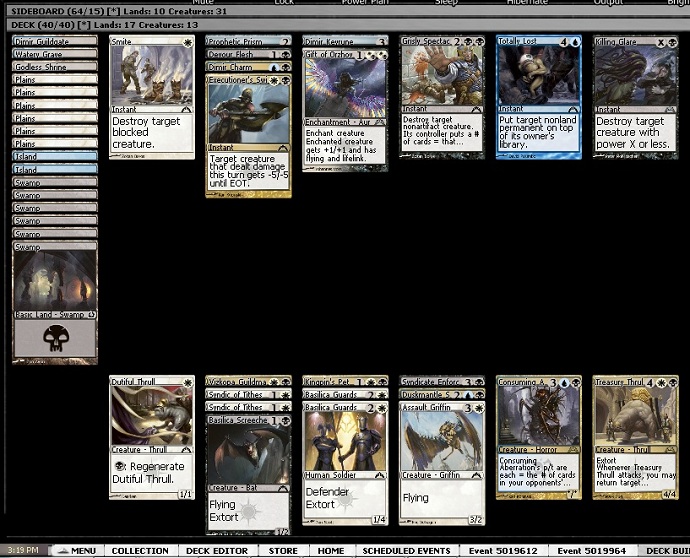
My favorite archetype by far is Esper. Whether it is U/B splash white or B/W splash blue, I think the advantage you gain with both extort and cipher is just so good. Many people think this format is very fast and that you want to make sure you don’t stumble on your mana. While this is true, I am fine with playing a more powerful three-color deck as long as you have the fixing. As you can see, in this build my mana was very good with the help of a few dual lands and a Dimir Keyrune. I felt very confident in both the way I decided to build my deck given my card pool and the actual deck itself. With eight rounds, I felt I would be able to go 7-1, which is what is needed to make Top 8.
The toughest decisions for me only really came down to the last few cards. The things I value in Sealed Deck are the following. I want to make sure I am playing my best cards. Leaving a bomb rare in the sideboard is something I really try to avoid. Sure, if I have two Simic bombs and two Orzhov bombs, I’m fine leaving either the Simic bombs or the Orzhov bombs in the board. So the first thing I do is sort by rarity. Once you know what bomb rares you have, then you can look to see if you have the color support to play them.
The next thing you want to do is make sure you have a good curve and synergy, which sometimes means playing less powerful cards so that your deck can work better as a unit. Even though I’m fine with playing slower three-color decks in this format, it’s still fast, so you want to have early plays. In Orzhov, some of the best common two-drops are Syndic of Tithes and Basilica Screecher. Both come down early, can trade or race with your opponent’s guys, and have Extort.
Also, one of the best common three-drops in Orzhov is Basilica Guards. Most of the Boros creatures have three power and lots of them have a one toughness, meaning Guards is a nightmare card for them. A Boros player might think, "Sure, it has four toughness, but I’ll just bloodrush a Skinbrand Goblin onto my attacker." That’s when they are setting themselves up to get blown out by another one of my favorite commons, Smite. Smite is a super powerful card that doesn’t get enough respect and goes late in Draft because the other white guild (Boros) doesn’t really want a defensive card like Smite.
Finally, you also want to have some removal in your deck, especially in a ten-round tournament. Just think about it—if you are sitting in the 7-0 bracket at GP Charlotte, there is a strong chance your opponent will have a very good deck with some really good creatures. Having removal is obviously important to remove creatures, but it’s not as simple as that. Lots of times, players will use their removal on a good creature and then will lose to their opponent’s bomb creature that they play next turn. The best advice here is if you are playing a controlling deck and pushing damage is not that important, strongly think about whether or not you need to use your removal on a certain creature or if you can just trade with it with your creatures instead.
I really felt this pool had it all and thought I had a great chance of making Top 8. The tournament started out well with a win in my first round. As you can see below, the deck played out superbly.

My opening hand lacked blue mana, but I felt since I had some early plays that I could stall out the game, which would give me more time to draw into my mana.
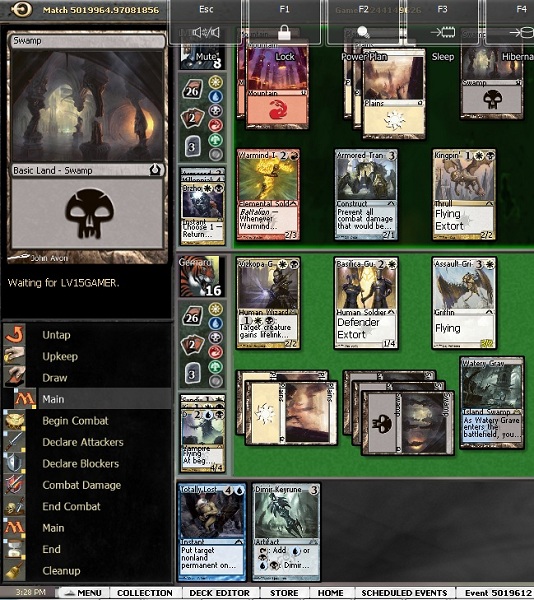
As the game progressed, I had my opponent on the back foot since I drew into the mana I needed and was able to use extort to recoup any early damage I might have taken.
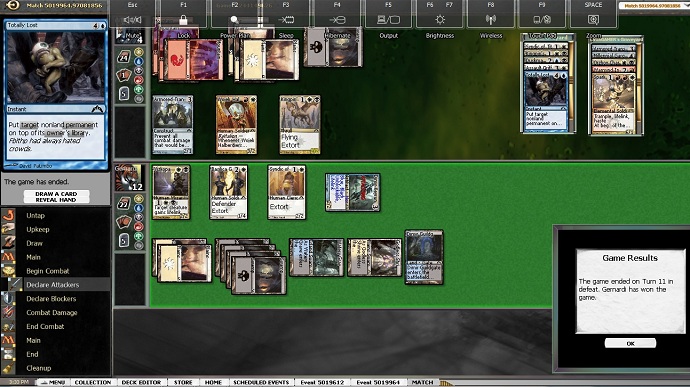
As you can see, I ended up finishing off my opponent with my unblockable Keyrune and Vizkopa Guildmage. The game was never really too close because my defense was too strong for my opponent to break through.
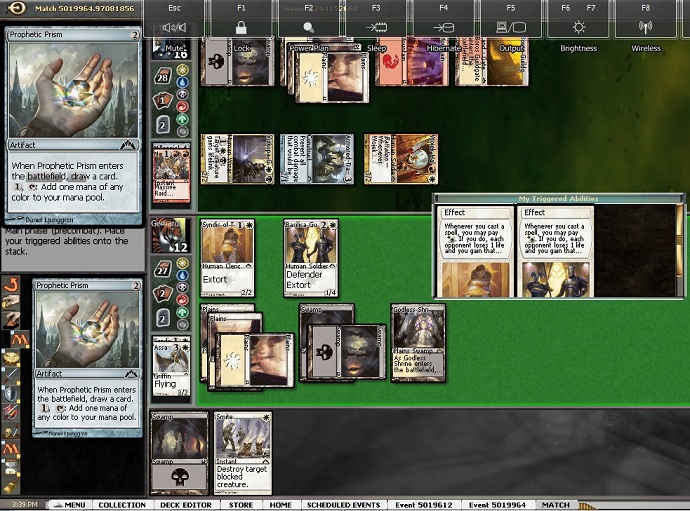
Game 2 was pretty much the same since I had a solid defense against his aggressive creatures. The screen shot above is to show the power of Prophetic Prism in both a three-color deck and an extort deck. Here I was able to fix my mana, cycle through my deck, and drain for two. Cycling through your deck is also important when you have a few really powerful cards in your deck because you will be more likely to draw them throughout the game.
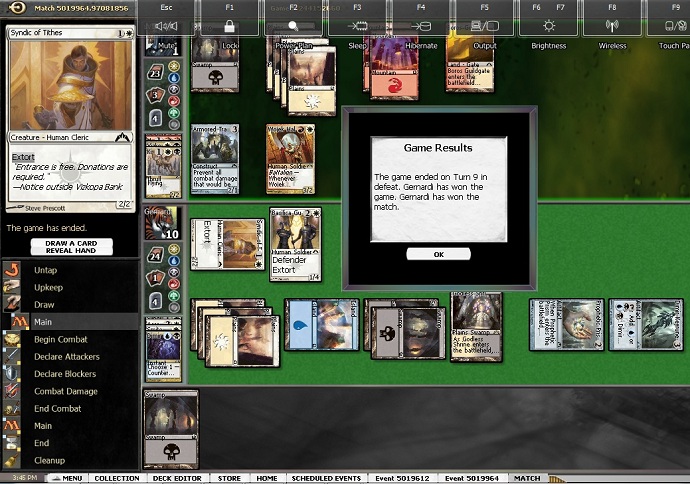
I ended up winning game 2 as well to take the match.
After the match, I took another look at my deck to see if there was anything I would change. Remember, at the GP you will only have a certain amount of time to build your deck and register all the cards. Afterward, though, you have time to talk to your friends and ask if they would have done anything differently. Even if you misbuilt your deck, there is no need to get discouraged because you can make any swaps with your sideboard between games.
Even if you didn’t misbuild your deck, you probably will have a large amount of sideboard options. In this format, there are cards like Naturalize, Act of Treason, Mental Vapors, and Zarichi Tiger that you might not maindeck but that can really shine in certain matchups. In some cases, siding into a whole new deck is an option, especially if you have a bad matchup such as R/W deck against a B/W control deck where their defense is too hard for you to push through.
Another thing I want to note is that in some formats, especially Sealed Deck, it is beneficial to be on the draw rather than the play. In this format, I can see arguments for both, but for most of the games, you would rather be on the play.
For round 2, things looked super close in game 1:
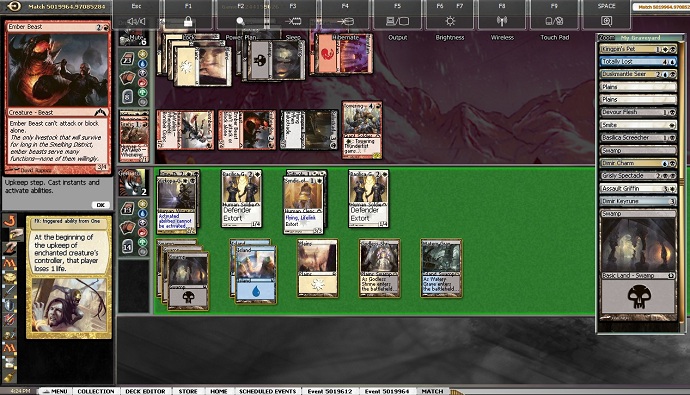
I put myself in a spot where I had to draw any spell to win the game. Instead, I bricked off and ended up losing both game 1 and eventually the match, putting me at 1-1 with what I thought was a very strong deck.
As the tournament went on, I was happy with the deck; however, I ended up with a 6-2 record and was one match short of making Top 8.
After coming so close, I decided to play in another Sealed event to get more practice with the format. My next pool was as follows.
Card Pool #2
- 2 Furious Resistance
- 1 Hellraiser Goblin
- 2 Last Thoughts
- 1 Mark for Death
- 1 Sage’s Row Denizen
- 1 Thespian’s Stage
- 1 Verdant Haven
- 2 Millennial Gargoyle
- 1 Frontline Medic
- 1 Contaminated Ground
- 1 Urban Evolution
- 1 Midnight Recovery
- 1 Dinrova Horror
- 1 Boros Elite
- 2 Hands of Binding
- 1 Smog Elemental
- 1 Legion Loyalist
- 1 Forced Adaptation
- 1 Keymaster Rogue
- 1 Basilica Guards
- 1 Warmind Infantry
- 1 Enter the Infinite
- 1 Stolen Identity
- 1 Razortip Whip
- 1 Call of the Nightwing
- 1 Skyknight Legionnaire
- 1 Syndicate Enforcer
- 1 Metropolis Sprite
- 1 Holy Mantle
- 1 Naturalize
- 2 Way of the Thief
- 1 Court Street Denizen
- 1 Urbis Protector
- 1 Adaptive Snapjaw
- 2 Knight Watch
- 1 Slaughterhorn
- 1 Illness in the Ranks
- 1 Syndic of Tithes
- 2 Crocanura
- 1 Rust Scarab
- 1 Horror of the Dim
- 2 Greenside Watcher
- 1 Boros Charm
- 1 Shambleshark
- 1 Wight of Precinct Six
- 1 Wojek Halberdiers
- 1 Bane Alley Broker
- 1 Massive Raid
- 2 Paranoid Delusions
- 1 Skarrg Guildmage
- 1 Hydroform
- 1 Nimbus Swimmer
- 1 Kingpin’s Pet
- 1 Scatter Arc
- 1 Mortus Strider
- 1 Primal Visitation
- 1 Domri Rade
- 1 Simic Guildgate
- 1 Basilica Screecher
- 1 Skinbrand Goblin
- 1 Shielded Passage
- 1 Dimir Guildgate
- 1 Ruination Wurm
- 1 Rubblebelt Raiders
- 1 Devour Flesh
- 1 Death’s Approach
- 1 Truefire Paladin
- 1 Crackling Perimeter
- 1 Shattering Blow
- 1 Voidwalk
- 2 Smite
- 1 Spire Tracer
- 1 Psychic Strike
- 1 Bomber Corps
Looking at this pool, I felt I had to drift away from my preference of Esper and go a more aggressive route with a Naya deck. This was very difficult to build since I had no on-color Gates and knew I wanted to be three colors so I could play with my powerful cards. After using almost the full amount of time, here is what I ended up with:
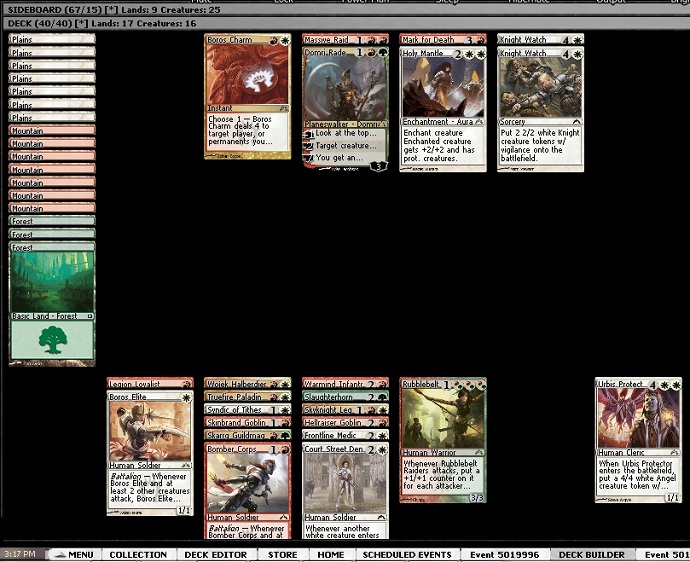
There were a few things I had to keep in mind while building this deck. I wanted to make sure I had enough creatures to make Domri Rade and battalion good, and I also wanted to keep green as light as possible to try to avoid mana issues. The deck played out ok, but I would much rather be the control player in this format. In too many games I found myself not being able to push through or gain any incremental advantage. My games with this deck were either me blowing out my opponent or them just playing a bunch of bigger guys and me sitting there somewhat hopeless.
I again picked up a loss early and then got my second loss in round 4, knocking me out of Top 8 contention very early. My second loss came at the hands of an Orzhov deck; after game 1, I boarded into a RUG version of the deck, but as seen below, the power of extort and a bomb rare made the game not even close.
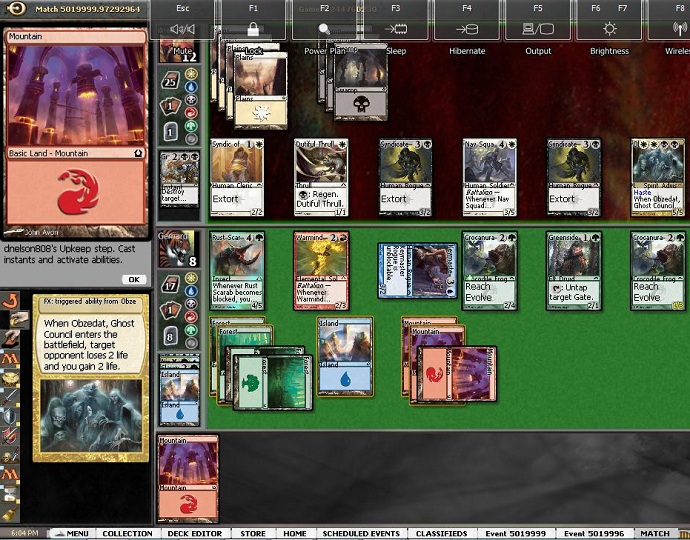
My reasoning for boarding into the RUG version was that I felt his deck wanted to go long. The longer the game goes, the better chance I have of taking of the game by either playing giant guys or having them turn into giant guys by putting +1/+1 counters on them. I was also able to side in Stolen Identity, which is one of the best cards in the format. It might have been better all along to build a RUG deck over Naya.
Now that you got to see two different pools and my thoughts on how I built them, I want to tell you about some of my favorite cards to draft in each archetype. I’ll start off with my favorite: Orzhov.
The Top 5 is in no particular order, and I added some notes to lots of my Top 5 lists because no draft is really ever the same; you should be able to adapt to what you need for your deck’s synergy and curve.
Orzhov Top 5
Best commons: Syndic of Tithes, Basilica Guards, Kingpin’s Pet, Basilica Screecher, Grisly Spectacle (honorable mention: Smite). Remember what I said above: Smite will often go later than it should, so you will be more likely to pick up a couple later in the draft and won’t have to value it so highly in your pick order.
Best uncommons: Killing Glare, Knight of Obligation, One Thousand Lashes, Orzhov Charm, Gift of Orzhova.
Dimir Top 5
Best commons: Grisly Spectacle, Balustrade Spy, Death’s Approach, Cloudfin Raptor, Deathcult Rogue.
Best uncommons: Call of the Nightwing, Dinrova Horror, Mindeye Drake, Killing Glare, Wight of Precinct Six.
Simic Top 5
Best commons: Cloudfin Raptor, Ivy Lane Denizen, Frilled Oculus, Shambleshark, Drakewing Krasis. (Depending on your curve, Adaptive Snapjaw could be a higher pick than Frilled Oculus / Shambleshark.)
Best uncommons: Experiment One, Simic Charm, Simic Fluxmage, Elusive Krasis, Zameck Guildmage. (I originally had Crowned Ceratok on the list, and although he is a 4/3 for four and will most likely give most of your guys trample, in certain matchups he just gets bricked walled by bigger guys, trades down, and doesn’t really do enough.)
Boros Top 5
Best commons: Ember Beast, Mugging, Madcap Skills, Skyknight Legionnaire, Wojek Halberdiers. (Massive Raid should be on here if you are short on removal.)
Best uncommons: Sunhome Guildmage, Truefire Paladin, Holy Mantle, Horning Lightning, Arrows of Justice.
Gruul Top 5
Best commons: Pit Fight, Zhur-Taa Swine, Slaughterhorn, Mugging, Ember Beast.
Best uncommons: Ghor-Clan Rampager, Skarrg Guildmage, Ground Assault, Horning Lighting, Wasteland Viper.
After all this, I decided to play in one more Sealed event; here is my pool. How would you have built it? I had many options. A screen shot of what I played is below.
Card Pool #3
- 1 Furious Resistance
- 1 Last Thoughts
- 1 Armored Transport
- 1 Sage’s Row Denizen
- 1 Illness in the Ranks
- 1 Verdant Haven
- 1 Gridlock
- 1 Contaminated Ground
- 1 Urban Evolution
- 1 Midnight Recovery
- 1 Illusionist’s Bracers
- 1 Leyline Phantom
- 1 Foundry Street Denizen
- 1 Firefist Striker
- 1 Grisly Spectacle
- 1 Smog Elemental
- 1 Legion Loyalist
- 1 Cloudfin Raptor
- 1 Realmwright
- 1 Mugging
- 1 Shadow Alley Denizen
- 1 Razortip Whip
- 1 Stolen Identity
- 2 Nav Squad Commandos
- 1 Consuming Aberration
- 1 Skyknight Legionnaire
- 1 Syndicate Enforcer
- 1 Dutiful Thrull
- 1 Holy Mantle
- 1 Disciple of the Old Ways
- 1 Way of the Thief
- 1 Coerced Confession
- 1 Riot Gear
- 1 Gutter Skulk
- 2 Knight Watch
- 1 Spell Rupture
- 1 Gruul Keyrune
- 1 Tin Street Market
- 1 Crocanura
- 1 Boros Keyrune
- 1 Smite
- 1 Horror of the Dim
- 2 Mark for Death
- 1 Greenside Watcher
- 1 Orzhov Charm
- 1 Madcap Skills
- 1 Act of Treason
- 1 Shambleshark
- 1 Arrows of Justice
- 1 Bane Alley Broker
- 1 Massive Raid
- 1 Skarrg Guildmage
- 1 Grisly Spectacle
- 2 Keymaster Rogue
- 2 Mortus Strider
- 1 Gift of Orzhova
- 1 Borborygmos Enraged
- 1 Forced Adaptation
- 1 Dimir Guildgate
- 1 Dimir Guildgate
- 2 Zhur-Taa Swine
- 1 Ruination Wurm
- 1 Corpse Blockade
- 1 Predator’s Rapport
- 1 Bioshift
- 2 Purge the Profane
- 1 Death’s Approach
- 1 Wildwood Rebirth
- 2 Guildscorn Ward
- 1 Naturalize
- 1 Balustrade Spy
- 1 Voidwalk
- 1 Slaughterhorn
- 1 Structural Collapse
- 1 Hindervines
- 1 Syndic of Tithes
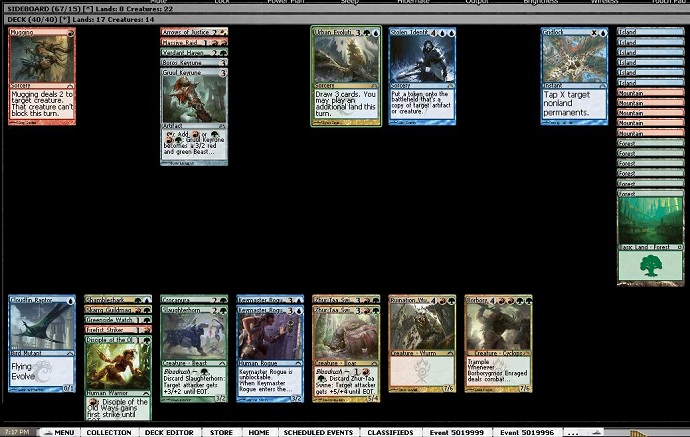
I ended up with RUG but really didn’t like how it played out. Overall, I would be happiest with a very strong Dimir and or Orzhov deck, but whatever you open you pretty much have to go with.
I really hope you guys learned something from this article. Just remember to think about your plays. Think about how you should use your removal, think about if you should run out your two-drop or if you should hold it so you can evolve your next creature, and think about your sideboard options. If you plan on going to Charlotte or if you have thoughts about this article, post your comments below or follow me on Twitter @Gfabs5.
Thanks for reading, and good luck from the Orzhov Syndicate!
Bonus section! Lots of times players are unsure how good a certain rare is; this is mostly because if you haven’t played the set that much, you probably haven’t played with or against most of the rares. It’s easy to see that Obzedat, Ghost Council is a bomb, but what about the other rares you might be unsure about? Let’s take a look…
I will only do the rares since out of the fifteen mythic rares, all of them besides Enter the Infinite are anywhere from good to just insane.
This is just a rough idea of the value of the rare, but it should help you see how high you should take the rare.
1 = Not really playable.
2 = Decent and will most likely make your deck.
3 = Very good. You should play it, but it isn’t always a first pick.
4 = Bomb and you should first pick it.
Gatecrash Rares
Alms Beast – 3
Angelic Skirmisher – 3
Assemble the Legion – 4
Biomass Mutation – 3
Biovisionary – 1
Blind Obedience – 3
Boros Reckoner – 3
Clan Defiance – 4
Consuming Aberration – 3
Crypt Ghast – 2
Diluvian Primordial – 3
Fathom Mage – 3
Firemane Avenger – 4
Five-Alarm Fire – 2
Foundry Champion – 3
Frontline Medic – 3
Glaring Spotlight – 1
Gruul Ragebeast – 3
Gyre Sage – 2
High Priest of Penance – 2
Illusionist’s Bracers – 1
Immortal Servitude – 2
Legion Loyalist – 2
Luminate Primordial – 3
Merciless Eviction – 3
Mind Grind – 3
Molten Primordial – 3
Mystic Genesis – 3
Nightveil Specter – 3
Ogre Slumlord – 2
Ooze Flux – 1
Realmwright – 1
Rubblebelt Raiders – 3
Rubblehulk – 3
Sepulchral Primordial – 3
Signal the Clans – 2
Simic Manipulator – 4
Skarrg Goliath – 3
Soul Ransom – 3
Spark Trooper – 2
Stolen Identity – 4
Sylvan Primordial – 3
Treasury Thrull – 3
Undercity Plague – 2
Unexpected Results – 1
Whispering Madness -1
Wrecking Ogre – 4
